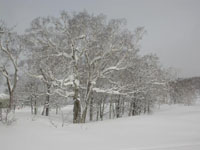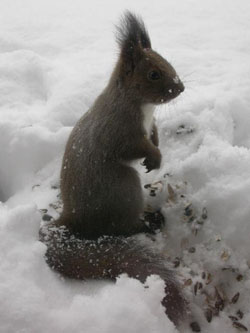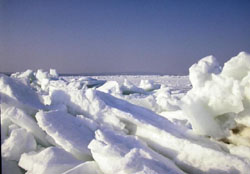Birch trees in a beautiful, snow-blanketed landscape at Niseko in Hokkaido
There's no time like snow time!
By Mark Brazil | Dec 19, 2007
As much as I enjoy the rich biodiversity of the Tropics — as anyone who read my column here last month on the wildlife of Brazil will know — my favorite season is winter.Somehow it is in my blood. When temperatures start dipping toward zero in late autumn, I am wont to smile at thoughts of the snow season ahead. For me there is something magical about a wind blasting in from the North, bringing with it glowering gray clouds whipping flakes of snow through the air.
Snow falls in an almost endless variety of ways: sometimes in a peppering of fine, hard pellets; sometimes wafting through the air like goose down or miniature pieces of an all-white quilt eager to assemble itself; at times heavier flakes seem in an earthbound hurry; while on occasions they seem reluctant to allow gravity to control them and dance on subtle currents that making them rise as well as fall.
I have watched snow fall from skies black with roiling thunderclouds, but also, magically at times, materializing in midair from periwinkle-blue skies. On brilliantly bright winter days, when the temperature is well below freezing, I have watched, too, the glinting crystals of “diamond dust” arriving like a pristine sandstorm to coat all around. The variety of snow’s forms is fascinating, and the conditions of its falling are so varied that being out in winter weather is never dull.
Equally as magical as the falling snow are the varied impacts of falling temperatures. Not only do the forests and mountains feel different as they become colder, but they sound different too. The pleasant rustling of piles of autumn leaves along hiking trails gives way to a chillier sound; even the rustling of sasa (dwarf bamboo) takes on a drier and colder sound once the mercury dips below freezing. Leafless branches knocking against each other in the wind rattle on cold winter days, their sounds increasingly muffled by the buildup of snow along their limbs.
Meanwhile, a skin of ice on a drying puddle cracks and tinkles like the sound of thin glass breaking; but as temperatures keep falling and freezing is sustained, pools and streams ice over and then crack with more ominous shattering sounds that can herald a muddying plunge and a suddenly shockingly wet foot!
Then, when freezing days are added to freezing nights, and weeks of winter accumulate, lakes begin to ice over. One winter, I arrived after midnight by Kussharo-ko Lake in eastern Hokkaido, on the very night it froze over. The sounds were surprising, symphonic, like a radiophonics workshop run wild; crackles, whizzes and pings broke in on soothing melodious tones, and in the distance it was as if a stagehand was experimenting with a thunder board and a caged lion.
Ice formation generates sounds that thrill — but try standing out on the ice of a river, particularly one close to the sea, where each tide pushes the ice upward; it’s a different experience entirely!
Rising and falling river ice freezes both from above and below, creating, in some winters, a layer thick enough to drive a truck across. But the midday sunshine normally thaws the uppermost surface, allowing puddles of water to form. Of course these later freeze as dusk approaches, but this process repeated day after day can lead to finely multilayered ice akin to flaky pastry. Step there, and layer after layer of the frozen confection shatters and explodes, pieces skittering off in all directions, and I can guarantee you will feel a surge of adrenaline.
Then there are the pressure ridges that form in thick ice where cracks form downriver as it rises and falls with the tides. As the tide drops, whole sections of ice shift and settle, letting off ominous crunches and cracking sounds that can frighten the inexperienced.
But that is as nothing compared with the sounds of sea ice.
The southernmost sea ice in the Northern Hemisphere is that on the Sea of Okhotsk over which northern Hokkaido looks out. This is seeded off northern Sakhalin and around the mouth of the Amur River in Russia’s Far East, and from there it can drift and extend south to the Hokkaido coast, to the Shiretoko Peninsula and even the Nemuro Channel.
Ice forms locally in Hokkaido too; but on a less grand scale. In shallow bays and calm harbors, a thick gel-like, rubbery skin of slushy ice crystals forms, damping waves down so that instead of cresting, they rise, roll and fall in a sluggish, oily fashion as if seals were swimming beneath blankets. I know from past, youthful risk-taking that there is a point when this slush-ice forms a blanket strong enough to just about support a person’s weight — if that foolhardy person keeps moving in a stumbling, hurried shuffle!
As sustained low temperatures fall further, patches of slush-ice coalesce and form pancakes of ice that jostle and rub against each until that pancake freezes all clear and glassy and the jostling edges pile up in a rim of whiter crystals that bring to this observer’s mind a frozen likenesses of Amazonian water lilies.
Then, harder freezing conditions lead to sheets of thick ice forming under calm conditions. Onshore winds bring in the larger blocks of sea ice crunching and smashing through the local stuff, but then sometimes it all freezes together in a mass along the beach. A coastal walk under these conditions, with the wind whipping in over a great expanse of sea ice, can chill you to the bone — but the sights and sounds are thrillingly dramatic.
Equally as thrilling, a little further inland, is the swishing sound on fine powder as you explore the backcountry on cross-country skis; or when pushing through it with snowshoes.
My own associations with winter are driven by childhood fantasies sparked by reading Arthur Ransome’s “Winter Holiday” (“Nagai Fuyu Yasumi” is the translated version’s title) while living in central England, where “winter” means week after week of low, gray cloudy skies and endless rain.
Experiencing Hokkaido’s winter climate for the first time was like a fantasy come true; where daylong blizzards were interspersed with high-pressure weather systems bringing colder temperatures but crystal-clear blue skies.
Seeing the Japan Alps of central Honshu in their winter setting for the first time was like beholding a parade of Swiss chocolate-box scenes. There is something about the pristine whiteness of it all, the clean lines, the unifying brush strokes of ice and snow that turn a potentially gray winter landscape into a dazzlingly white one that I can gaze at for hour after hour.
Perhaps it’s the inevitable questions that arise that make winter so fascinating. How do insects survive the freezing? How do small mammals live beneath the snow? Why don’t small birds freeze solid at night? Why do some mammals hibernate, but others of the same size remain active? How do green plants cope with so little light in winter — and why do others shed their leaves? What are the consequences of more or less snow, of milder winters, of ice-free lakes?
My personal excitement at the approach of winter is now tempered by the knowledge that it is a season in retreat. My travels in the Asian and North American Arctic have brought me into contact with diverse northern peoples whose experiences all resonate with my own reflections on changes I recognize here in Hokkaido where I live. The first autumn freeze comes later, the spring earlier; first snows are both later and lighter; and unprecedented rains fall in the middle of what should be endless weeks of subzero weather. Rivers, once used as ice-clad winter highways, suddenly break apart and remain ice free for days, or even weeks at a time, and lakes that once froze over remain ice free.
Last winter, for example, Lake Kussharo here in eastern Hokkaido failed to freeze over — for the first time in recorded history. My sense of sadness at the loss of winter is merely personal, but what of the ecological consequences? Well, more of that next time . . .



